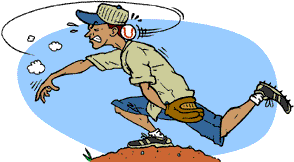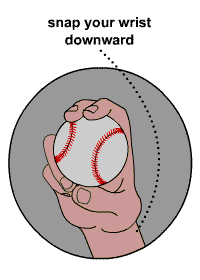![]()
![]()
Curve Ball

Let's face it: curve balls
are cool. A well-thrown one looks like a movie special effect. One
instant the ball is heading in a more-or-less straight line--then
suddenly (as if it thought of something better to do) it swoops off
and down to one side, utterly unnerving the batter.
What happened?
Physics, that's what. While ball players tend to be mysterious about the process, the reality is that it's a simple (if somewhat counter-intuitive) procedure: spin the ball as it leaves your hand. This 2torial will talk you through the essentials of mastering the curve. We can't guarantee you'll make the majors, but we can at least make you look a little cooler up there on the mound.
|
Before you start, you should know about the effects that pitching can have on the body. Coaches and doctors agree that overpitching can cause serious strain on a player's arm, especially if that player is under 16 (or so) and has a body that isn't fully developed. Curve balls can be particularly tough on this age group, and sometimes dangerous. Make sure you or the person you're teaching are physically ready, and don't overdo it. |
The curve ball is held with the fingers close together and thrown with sidespin. This alters the speed and trajectory of the ball, throwing off a batter's timing and swing location. Use it when the batter may be expecting a fastball.
![]()
|
|
|
![]()
|
|
|
![]()
|
|
|
![]()
Skills Drills
Catch
Practice control of the curve by playing an easy game of catch with a partner standing pitching distance away. Throw curve balls gently and award one point for each throw to the middle of the other player's chest. Play to 10, 15 or 21. Throw easy to get used to the pitch and to lower the risk of injury while learning the curve ball.
![]()
Troubleshooting Tips
Pain and Discomfort
If you encounter any pain or discomfort while throwing the curve, stop immediately. Improper curve ball technique can lead to serious injuries.
Have Patience
Patience is vital when learning the curve ball. With practice, you can have the action and control of your curve. It may take longer to perfect than the fastball, but hang in there!
Wrist Snap
If your curve ball is not breaking sharply, you may be snapping your wrist sideways instead of downward.

This
site is awarded the

In
recognition of creativity, integrity and excellence on the Web.
 The
term "Little League" and the Little League logo are
trademarks of Little League Baseball, Inc., Williamsport, Pa.,
extended only to local chartered leagues for purposes of
identification and publicity
The
term "Little League" and the Little League logo are
trademarks of Little League Baseball, Inc., Williamsport, Pa.,
extended only to local chartered leagues for purposes of
identification and publicity
Copyright © 2000 Brookside Little League, Inc. All rights reserved
Brookside Little League, Inc.

Thank you , for visiting Brookside's Little Legue Web Site
![]()
by
Jon Anderson
jontanderson@juno.com